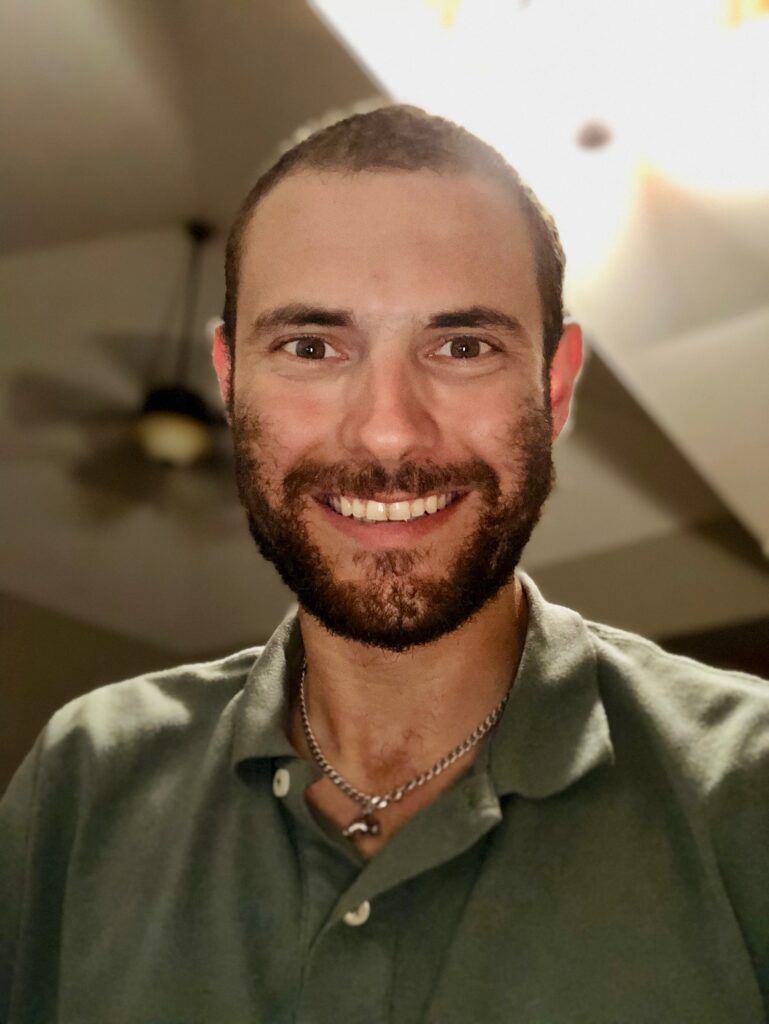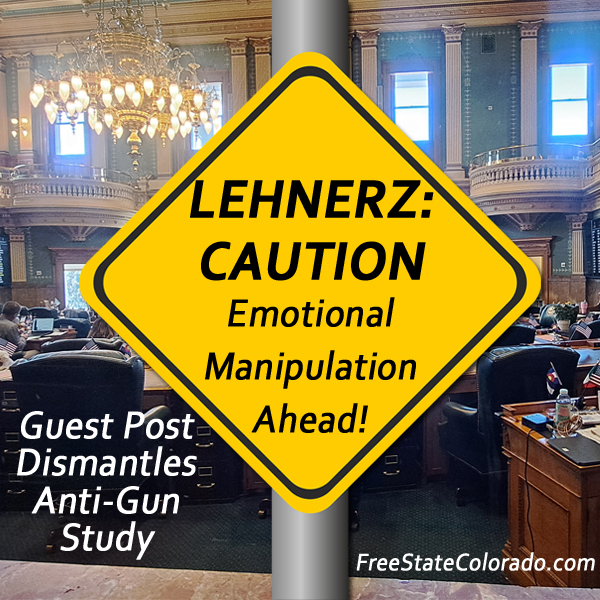Guest post by Frank Lehnerz
This year’s General Assembly has not been without its hours and hours of convincing and emotional testimonies that place heavy emotive narratives over hard facts especially when it comes to SB25-003. As this bill evolved from a flat out ban to a may-issue buy-back-your-rights scheme, a gleaming new study emerged from the bowels of the Ivory Tower. It claims that one in fifteen Americans have over the course of their lives been involved in a mass shooting.
This study entered the record during the ending hours of the second reading on the House Floor last week by none other than one of the bill’s primary sponsors, Representative Andy Boesnecker of Fort Collins:
“I was struck by an article in a newspaper that I read that I think is really important to name here. And that is a recent study by what I would call the second best university in the state of Colorado that I won’t name here, showing that one in 15 people in our country have been present at the scene of a mass shooting. I want to just reiterate that a second—that one in 15 people in our country have been subjected to the violence, trauma, loss, and grief that is unimaginable and yet all too real for too many people in our country and state. The ripple effects of that trauma are real as well. School children, teachers, all training for a moment we pray never comes. As a former public school teacher and the parent of three children, not a day goes by that I don’t worry.” (Link to video)
Rep. Boesnecker’s citation of a newspaper article and not the actual study aside is a subtle game of “telephone.” His claim that “one in fifteen” Americans have been present at a mass shooting is a textbook example of how emotionally resonant “statistics” typical of gun control research can be mobilized in service of his broader political agenda.
Gun control politicians, academia, and media tend to operate with an uncharitable bias against firearm usage and their owners. Gun rights activists and realists likely already know to proceed with caution when interpreting and invoking this “one in fifteen” study. This bias is something Professor David Yamane author of the book Gun Curious: A Liberal Professor’s Surprising Journey Inside America’s Gun Culture calls the “Standard Model of Firearm Ownership and Use” which posits that guns should be treated by default as deviant social problems, not as tools of individual agency, legitimate self-defense, or for suppression of tyranny.
That one in fifteen figure originates from Direct Exposure to Mass Shootings Among US Adults by Drs. David C. Pyrooz, James A. Densley, and Jillian K. Peterson published in the journal JAMA Network Open.
Their study that surveyed 10,000 U.S. adults about their lifetime exposure to gun violence. The headline “statistic” being repeated is technically accurate—within the study’s parameters—but the conclusion it invites is far less sound making it inappropriate for fact-based discussions around SB25-003.
That’s because the study’s methodological choices, limitations in sampling, and use of statistical modeling all introduce uncertainty. Moreover, its findings are being weaponized not just on the House floor but also in University press releases, regime media and gun control circles to support claims that the data simply cannot bear—particularly concerning school shootings and so-called “assault weapons.” It will likely become new ”knowledge” among these circles as it receives more citations by other academics, more coverage in regime media, and more soapbox pleas in lawmaking bodies.
However when we look deeper, the study tells us much less about mass shootings than it initially seems to—and much more about the dangers of statistical rhetoric and cheap emotional manipulation by the bill sponsor.
What the Study Actually Shows
The study asked a 10,000 person, demographically weighted sample of U.S. adults whether they had ever been physically present at a mass shooting—defined as an incident in which four or more people were shot in a public place. It found that 6.95% reported being present during such an event at some point in their life, and 2.18% reported sustaining injuries (e.g., being shot or trampled). Being “present” does not necessarily being involved or a victim of such shootings. It can be as simple as hearing nearby gunshots.
The authors employed multivariable logistic regression to analyze the relationship between exposure and various demographic variables, including age, gender, and race. Multivariable logistic regression is a statistical method used to predict the likelihood of an event occurring (e.g., yes/no) based on multiple factors simultaneously. In doing so, they produced adjusted odds ratios (AORs), allowing them to make controlled comparisons between groups (e.g., Gen Z vs. Baby Boomers, men vs. women). For instance, males had a 55% higher likelihood of exposure than females, and Black respondents were nearly twice as likely as White respondents to report being present at a mass shooting.
These numbers sound precise—but the precision is more statistical than substantive. Odds ratios, while common in public health research, are easily misunderstood and often exaggerate the impression of risk, especially when the underlying event (here, injury from a mass shooting) is rare. Moreover, the logistic model assumes a linear, additive relationship between demographic factors and the log-odds of exposure, which does not capture the true complexity of gun violence.
Three Main Issues With The Researchers’ Statistical Methods
There are three main issues with the statistical methods used in this study:
1. Weighted Survey Limitations
The study uses an opt-in online panel through YouGov, not a truly random sample. To correct for this, the authors applied post-stratification weights to align the sample with national demographics. But weighting is no magic bullet. It assumes that if you correct for age, race, income, and education, everything else about your sample becomes representative. It cannot correct for unmeasured biases, like heightened media awareness, trauma salience, or the inclination to self-identify an incident as a “mass shooting.”
Additionally, weights can amplify error when applied to small or extreme subsamples. If just a few highly weighted individuals report an unusual experience, they can disproportionately affect estimates scales up to the population level.
2. Logistic Regression in Rare Events
The use of logistic regression is standard in these studies, but potentially misleading in cases of rare outcomes. When only 2.18% of respondents report injury, the odds ratios produced can be unstable, and their interpretation becomes tricky. For instance, a doubling of odds may only reflect a change from 1% to 2%, which sounds large in relative terms but small in absolute terms.
Moreover, the assumptions of logistic regression—that effects are consistent across all levels of exposure, and that all relevant variables are included—are strong assumptions in a context as messy as interpersonal violence.
3. Self-Reported and Retrospective
The study relies entirely on self-reporting of past traumatic events, which introduces recall bias and subjective interpretation. What counts as a “mass shooting” to one respondent may not to another. The study defined “physically present” in relatively broad terms—hearing gunfire, seeing the shooter, or being in the immediate vicinity—but offered no verification.
Subjecting Boesnecker’s Beliefs to Reality
The late Carl Sagan was fond of saying, “You can’t convince a believer of anything, for their belief is not based on evidence, it’s based on a deep-seated need to believe.”
The real trouble begins when the study’s data leave the journal and enter the political arena. Rep. Boesnecker leverages the “one in fifteen” figure to support an emotional narrative centered on school shootings, children, and so-called ‘military-style” rifles “of war,” as part of his desperate moral crusade to shove this utterly unpopular, ineffective, and unconstitutional law to the Governor’s desk. This is a misdirection and of course nothing new from Rep. Boesnecker who was initially brought on as a vacancy appointment, never seen a gun-control bill he doesn’t like, and later won re-election due in part to Blueprint money. He’s also been none other than hostile to the Colorado Sheriffs in opposition to the bill.
As Handwaving Freakoutry makes clear in “The Gun Violence War Zone, Evaluated” and “The HWFO Gun Argument Tree,” most mass shootings—particularly those included in the Gun Violence Archive’s data, which this study leans on—occur in violence-prone neighborhoods and involve mostly handguns, not AR-15s or other scary-looking rifles. AR-15 and related rifle deaths, which are the real target of SB25-003 are so rare in fact they fall in between “Death By Bucket” and “Death By Lawnmower” as noted in also in Handwaving Freakoutry’s detailed article “AR-15s are Mindbogglingly Safe.”
School shootings and other public massacres using firearms are ultra rare relative to firearm suicides and general crimes using firearms most of which do not use the rifles targeted by SB25-003. Figures for school shootings are also subject to gross exaggeration and manipulation up to counting simple brandishing of firearms alone on school property or if a bullet fired outside the property hits somewhere on the property under the school shooting umbrella.
Such pesky facts of course are left out of the bill supporter’s soapbox pleas, the red-shirt Karen testimonies, and testimonies of the manipulated school children who are sold a catastrophic narrative about their safety. In reality, a student’s ride to school in the car carries significantly greater risk of injury or death than school shootings. But the imagery of children in lockdown and teachers in trauma is used to justify SB25-003—a classic case of policy driven by optics, not outcomes.
Proceeding With Rigor, Not Rhetoric
None of this is to say that gun violence (however its defined) is not real, traumatic, or worthy of public attention. But the statistical reality is far more complicated than the political talking points suggest. The “one in fifteen” statistic is not meaningless, but its interpretation is highly contingent on how we define exposure, who we survey, and how we model the results.
It says something—but not what Rep. Boesnecker wants you to believe.
So-called “assault rifles” or “weapons of war” are not driving America’s gun violence problem. Schools are not “war zones” nor are other public places either. Emotional appeals—however sincere—should not substitute for sound empirical reasoning.
If we are serious about addressing gun violence, we need sound policies guided by clear definitions, accurate data, and rigorous analysis. We need academia to branch out of tunnel vision perspectives dominant in the Standard Model of Firearm Ownership and Use. We need honest politicians who listen and respond to all perspectives. (Looking at you, Rep. Boesnecker, as one of your constituents whose tried to reach out to you in honest conversation only to be ignored.)
So yes—one in fifteen may have been present at a mass shooting in this ultra specific and adjusted study. But what counts as a mass shooting, how that number was derived, and what policy conclusions we draw from it—that’s where we must proceed with caution.

Frank Lehnerz is a Fort Collins-based engineer who works in the electric energy industry, and he is interested in promoting the message of Liberty.





